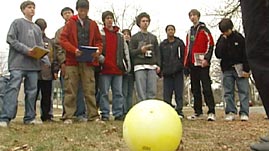Teachers' Domain - Digital Media for the Classroom and Professional Development
User: Preview

Source: WGBH Educational Foundation


A common question for the teaching of science is how to concretize the abstract. It is easy to assume that what is concrete to the science teacher is concrete to the student. However, when students actually work with particular content, the concepts may become too overwhelming in size and scope.
In this light, concrete representations can be a benefit to students’ understanding. By working with real-world scenarios, students can translate difficult ideas or scales into a more intuitive and active form.
In his Earth and space science class shown in this video, teacher Mark Goldner uses an outdoor walking exercise to help students conceive and figure out the distance between celestial bodies like the Sun and planets. The exercise gives a concrete, real-world scenario in which students can practice the abstractions of astronomy.
Like visualizations, physical activities provide a familiar and imaginative form for students to play out concepts. Goldner’s “solar-system experience” is a kind of theater in which students can physically act out distances by pacing. This overcomes the abstract scale of the solar system that is difficult to imagine or condense into a size that makes sense to many students.
 Loading Standards
Loading Standards